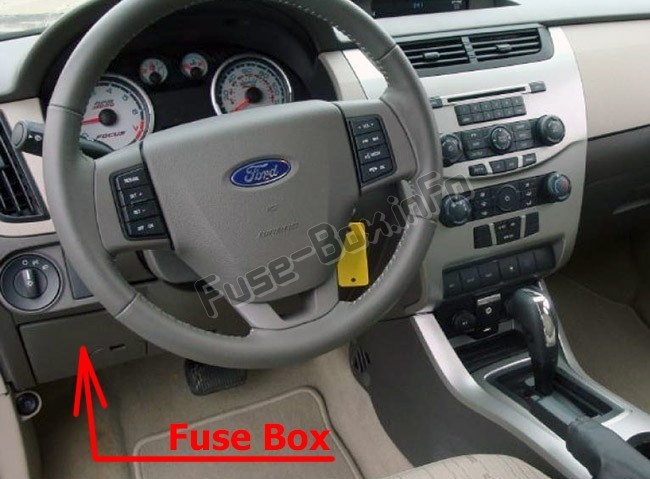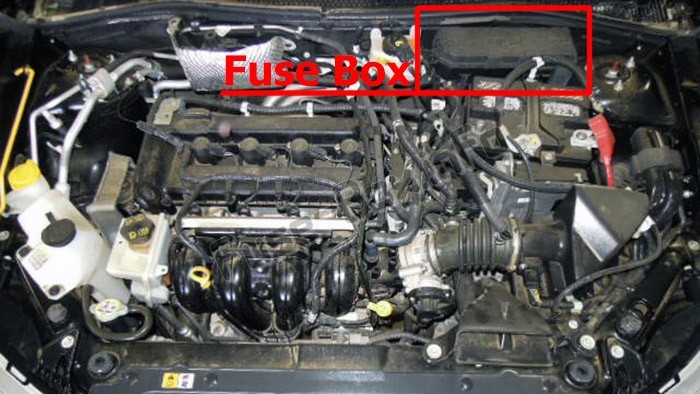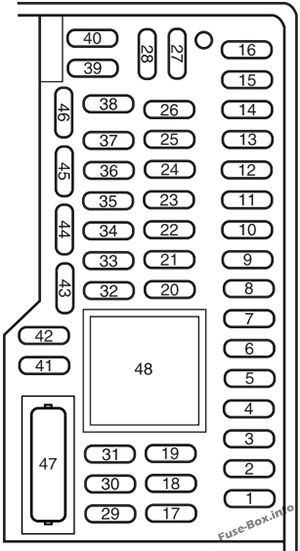Diagnosing issues with your 2010 Ford Focus often starts with checking the On-Board Diagnostics II (OBD2) port. This crucial port allows mechanics and car owners to read diagnostic trouble codes, providing insights into your vehicle’s health. However, if your OBD2 port isn’t working, a blown fuse is a common culprit. Locating the correct fuse is the first step to resolving this issue and getting your diagnostics back online. This guide will walk you through finding the 2010 Ford Focus Obd2 Fuse Location and understanding the fuse box diagrams, ensuring you can troubleshoot effectively.
Fuse Box Locations in Your 2010 Ford Focus
To begin your fuse hunt, you’ll need to know where the fuse boxes are located in your 2010 Ford Focus. Like most vehicles, the Ford Focus has more than one fuse box to distribute electrical loads efficiently. For the 2010 model, you’ll primarily be concerned with two main locations: the passenger compartment and the engine compartment.
Passenger Compartment Fuse Box
The passenger compartment fuse box is typically the first place to check for interior electrical issues, and it’s also where you’ll find the fuse related to the OBD2 port. You can find this fuse panel conveniently located inside the car.
To access it:
- Look below the steering wheel, towards the left side.
- You’ll need to remove the cover panel underneath the steering wheel, near the brake pedal. This cover is usually held in place by clips and can be gently pulled off.
- Once the cover is removed, you will see the passenger compartment fuse box.
Engine Compartment Fuse Box
The engine compartment fuse box, also known as the power distribution box, manages fuses and relays for components in the engine bay and other critical vehicle systems. While the OBD2 port fuse is usually in the passenger compartment, it’s good to be aware of this second location for other potential electrical issues.
To find it:
- Open the hood of your 2010 Ford Focus.
- Locate the black plastic box, usually on either the driver’s or passenger’s side of the engine bay, often near the battery.
- This is the engine compartment fuse box. The cover will have markings and clips to secure it.
2010 Ford Focus Fuse Diagrams and the OBD2 Port Fuse
Now that you know where the fuse boxes are, let’s pinpoint the specific fuse for your OBD2 port. Fuse diagrams are essential for identifying the correct fuse and understanding its function. Below are the fuse diagrams for both the passenger and engine compartments of a 2010 Ford Focus. We’ll focus on the passenger compartment diagram as it contains the Data Link Connector fuse, which powers the OBD2 port.
2010 Ford Focus Passenger Compartment Fuse Box Diagram
This diagram details the fuses located inside the passenger compartment fuse box. Refer to this chart to locate the fuse associated with the Data Link Connector.
2010 Ford Focus – Passenger Compartment Fuse Assignment Table
| № | Amp Rating | Protected Circuits |
|---|---|---|
| 1 | 30A | Not used (spare) |
| 2 | 15A | Brake switch (high-mount brake lamp) |
| 3 | 15A | Not used (spare) |
| 4 | 30A | Not used (spare) |
| 5 | 10A | Shift interlock |
| 6 | 20A | Right front turn lamp/Left front turn lamp, Rear stop/turn lamps |
| 7 | 10A | Left low beam headlamp |
| 8 | 10A | Right low beam headlamp |
| 9 | 15A | Interior lamps |
| 10 | 15A | Instrument panel backlighting |
| 11 | 10A | Not used (spare) |
| 12 | 7.5A | Power mirrors |
| 13 | 5A | SYNC® |
| 14 | 10A | Not used (spare) |
| 15 | 10A | Recirculated air, Air conditioning |
| 16 | 15A | Not used (spare) |
| 17 | 20A | Power locks, Trunk release |
| 18 | 20A | Heated seats |
| 19 | 25A | Not used (spare) |
| 20 | 15A | Data link connector |
| 21 | 15A | Fog lamps, Fog lamp indicator |
| 22 | 15A | Parking lamps |
| 23 | 15A | High beam lamps |
| 24 | 20A | Horn |
| 25 | 10A | Demand lamps, Trunk lamps |
| 26 | 10A | Instrument cluster |
| 27 | 20A | Ignition switch |
| 28 | 5A | Radio (Start) |
| 29 | 5A | Instrument cluster (Run/Start) |
| 30 | 5A | Not used (spare) |
| 31 | 10A | Not used (spare) |
| 32 | 10A | Restraints control module |
| 33 | 10A | Not used (spare) |
| 34 | 5A | Not used (spare) |
| 35 | 10A | Anti-lock brake system (ABS) |
| 36 | 5A | Passive anti-theft system (PATS) module |
| 37 | 10A | Climate control (Run/Start) |
| 38 | 20A | Subwoofer |
| 39 | 20A | Radio, Center information display, Electronic finish panel |
| 40 | 20A | Not used (spare) |
| 41 | 15A | Door lock/sunroof switch illumination, Auto dimming rear view mirror, Ambient lighting |
| 42 | 10A | Not used (spare) |
| 43 | 10A | Not used (spare) |
| 44 | 10A | Not used (spare) |
| 45 | 5A | Front wipers (logic) |
| 46 | 7.5A | Front passenger sensing system |
| 47 | 30A (circuit breaker) | Sunroof, Power windows |
| 48 | — | Delayed accessory relay |



As you can see from the diagram and table, Fuse #20 (15A) in the passenger compartment fuse box is designated for the Data Link Connector. This is the fuse you need to check for your 2010 Ford Focus OBD2 port issues.
2010 Ford Focus Engine Compartment Fuse Box Diagram
While less likely to be directly related to the OBD2 port malfunction, here is the engine compartment fuse box diagram for your reference in case you need to investigate other electrical components.
2010 Ford Focus – Engine Compartment Fuse Assignment Table
| № | Amp Rating | Protected Circuits |
|---|---|---|
| 1 | 15A | Heated mirror |
| 2 | 30A | Rear defrost |
| 3 | 20A | Power point |
| 4 | 20A | Fuel pump |
| 5 | 10A | Powertrain control module (PCM) keep alive power, Canister Vent |
| 6 | 15A | Alt sense |
| 7 | 10A | Reverse lamps |
| 8 | — | Not used |
| 9 | 40A | Anti-lock brake system (ABS) motor |
| 10 | 30A | Wipers |
| 11 | 30A | Starter |
| 12 | 40A | Blower |
| 13 | 10A | A/C clutch |
| 14 | 10A | PCM relay coil |
| 15 | 20A | Power point |
| 16 | 20A | Cooling fan—low |
| 17 | 30A | Cooling fan—high |
| 18 | 20A | ABS solenoid |
| 19 | — | Not used |
| 20 | — | A/C clutch relay |
| 21A | Rear defrost relay | |
| 21B | — | Not used |
| 21C | — | Blower relay |
| 21D | — | PCM relay |
| 22 | 10A | Fuel injector |
| 23 | — | Not used |
| 24 | — | Not used |
| 25 | — | Not used |
| 26 | 15A | PCM – emission related powertrain components |
| 27 | — | Not used |
| 28 | 15A | PCM |
| 29 | 15A | Ignition |
| 30A | — | Cooling fan low speed relay |
| 30B | — | Starter relay |
| 30C | — | Not used |
| 30D | — | Cooling fan high speed relay |
| 31A | — | Reverse lamp relay |
| 31B | — | Fuel pump relay |
| 31C | — | Wiper power relay |
| 31D | — | Not used |
| 31E | — | Not used |
| 31F | — | Not used |
| 32 | — | A/C clutch diode |
| 33 | — | EEC diode |
| 34 | — | One touch integrated start (OTIS) diode |
| 35 | 10A | Run/Start |
Troubleshooting and Fuse Replacement
Once you have located Fuse #20 in the passenger compartment fuse box, follow these steps to check and replace it if necessary:
- Turn off the ignition and ensure your Ford Focus is completely off.
- Locate the passenger compartment fuse box as described earlier.
- Identify Fuse #20 (15A) using the diagram provided inside the fuse box cover or this guide.
- Inspect the fuse: Use a fuse puller (often found in the fuse box or engine compartment fuse box) or needle-nose pliers to gently remove the fuse. Hold it up to the light to see if the thin wire inside is broken or melted. A broken wire indicates a blown fuse.
- Replace the fuse: If the fuse is blown, replace it with a new 15A fuse of the same type. Important: Always use the correct amperage and type of fuse. Using a fuse with a higher amperage can damage your vehicle’s electrical system.
- Test the OBD2 port: After replacing the fuse, try using your OBD2 scanner again to see if it’s now working.
If replacing the fuse doesn’t solve the problem, there might be a more complex issue with your OBD2 port or vehicle’s electrical system. In such cases, it’s recommended to consult a qualified mechanic for further diagnosis and repair.
To learn more about fuses and troubleshooting, refer to these helpful articles:
- How to check the fuses?
- How to replace a blown fuse?
- Why do car fuses blow?
- Types of automotive fuses
By following this guide, you should be able to easily locate the 2010 Ford Focus OBD2 fuse and troubleshoot common OBD2 port issues related to blown fuses. Regularly checking your fuses is a simple yet effective way to maintain your vehicle’s electrical system and prevent more significant problems down the road.